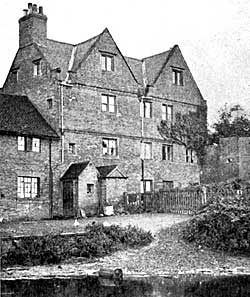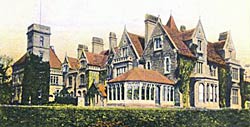THE 16th century witnessed so many changes in ownership that it may almost be said that by its close a new race of proprietors had appeared. In 1501 Sir John Babington died without issue and his Bramcote estate passed, bythe marriage of a niece, to the Delves. The marriage of an heiress ofthat house soon transferred it to Sir Robert Sheffield, while in 1512 the Strelley possessions here similarly came to the Poutrells. Upon the death of Sir Robert in 1531 the inheritance of his heir was ''by pretext'' seized by the Earl of Shrewsbury, but was eventually returned, and in the reign of Elizabeth the properties were broken up and sold to small freeholders.

The north side of Bramcote Manor House, c.1910.
About 1511 Sir Henry Willoughby, with Anthony and Nicholas Fitz-herbert and others, claimed properties here and hereabouts against Rd. Bingham of Watnall. This Anthony was the famous Judge whose existence proved a stumbling-block to Thoroton. He was brother-in-law and sole executor of John Willoughby of Wollaton, and his equivocal conduct in obtaining estates caused him to be accused of fraud. In 1515 he was sued by Sir Henry Willoughby for properties in this district, but he seems to have held that which he got, however, it came, and in the time of Queen Elizabeth his descendant erected the gabled red brick mansion which still exists, in richly mellowed beauty, though no longer as a manor-house. Church Interests. By the time of Henry VIII, Darley-Abbey and Felley Priory, in addition to Sempringham and Lenton, had interests here, that of the last being a rental of 7s. At the Dissolution, Sempringham's manor was sold to two monastic jobbers, Jackson and Mason, from whom, they were purchased by Thomas Hanley (or Handley) who had to sue Jackson for possession. He also bought the Bramcote possessions of Lenton Priory and made his seat here. The Darley land, etc., was obtained by Robt. Sacheverel, who did not long retain it, and Felley's rental probably passed to. Wm. Bolles who had to defend his interests here against Wm. Eytone. In 1548 it was found that the endowment rentals of the Babington chantry had for the past two years been detained by Edmund Sheffield as the descendant of the founder.
Thomas Hanley's grandson Henry succeeded to the estates in 1608 and at once commenced to enlarge his patrimony. He leased to Sir Perceval Willoughby some of his land on Bramcote Moor for the getting of "all the cooles, colemynes, and veynes and delfes of cooles lyinge and beinge in the waste's, moores, and common groundes of the said Henry in Brampcote,"with the right to "dig, delve, and make pitt and pittes," and to make soughs, use timber, create dumps, and open ground where he liked in search of the "cooles." The lease was for 21 years, the rental 20s. per annum, but the lessee was to deliver four loads of coal at Hanley's residence every year and permit him to collect a further 40; loads. A clause in the agreement provided that at the expiration of that period Sir Perceval was to deliver up the mines in working order, and it may have been this stipulation which caused Mr. Hanley to sue Sir Perceval later on "for the manor and coal mines of Brampcotes." How that action finished is not known, but in the 18th century Lord Middleton had a colliery here, a fact which seems to suggest a settlement that left the "pittes" in his ancestor's occupation; but the workings have long been closed down.
Many Charities.
By his will in 1650 this Henry Hanley devised numerous charities to Nottingham and various villages. He died in that year leaving no issue and the Bramcote poor benefited by £5 a year. He bequeathed £20 a year for a preaching minister who should reside in the village, and added a third bell to the church. The descent of his extensive properties created something of a scandal, for his kinsman and executor, Robt. Harding, barrister-at-law, secured possession to the detriment of Gervase Hanley of Wilford, who instituted a lawsuit but died before the hearing was concluded. Harding's claim was no further resisted, but in 1660 he was being sued by the rector of Wollaton for withholding tithes due from fields and closes called "a great flatt on Stony Furlong butting on the Milker's Path, Round Knoll Flat, Robin Hood Flat, Breedon Balk," and, among others "Brinsley Wonge near the Pikes."
Harding was not allowed to enjoy his gains in peace, and in 1679 he was prosecuted for abuse concerning Henry Hanley's charities, when his neighbour Ralph Edge of Strelley, also an attorney, and town clergy of Nottingham, alleged that "being a lawyer and an active man, he had got the entire management into his own hands, as also, the title deeds, and, having bought certain lands, claimed to be possessor of the whole.
"The House of Lords MSS. record the further accusation that Harding had torn up an important document, and that Edge had pieced it together, again. The defendant was ordered to deliver the lands in question (including Bramcote) to the custody of two independent gentlemen, and Edge was directed to answer Harding's, claims; but the latter dropped his appeal, and ended his local associations by selling the manor to John Sherwin.
The new lord of Bramcote was mayor of Nottingham during-part of 1687, and was fined 100 marks by Judge Jeffreys for opposing the surrender of the town charters at the behest of James II. His descendants retained Bramcote until 1809 when it came to John Longden, who had married the sister of the last male representative of the Sherwin family.
Gunpowder Plot.
In 1675 Thos. Hollingworth bequeathed Pilkington Close (subsequently exchanged for 6a. of land called the Clays) for the parish poor, and in 1689-perhaps inspired by the "Glorious Revolution" of the previous year—Thos. Charlton, of Chilwell, purchased a Bramcoat close, called Ashflat, for charity payments of £4 6s. per annum, including, a sermon in Attenborough Church every 5th of November to comemmorate the Gunpowder Plot. Mary Charlton in 1720 left £10 which was invested in land, and a person of the name of Jefferies left a rent-charge of 2s. 6d, which Mr. Wm. Charlton was paying in 1828. The township has not fared ill in the matter of charities, and in 1852 Miss Longden, who had inherited the old Hanley properties, built and endowed an almhouse for four poor women, who each received 2s. weekly, and two tons of coal every year. The accumulated charities now yield £24 per annum which is distributed on Christmas and New Year's Days in doles varying from 2s 6d. to 7s. 6d.

Bramcote Hall, c,1910.
Victorian Bramcote was a favourite place of residence for Nottingham manufacturers, some of whom erected fine houses, put the trek had begun much earlier, and among the early comers was Wm. Ayscough, who introduced printing into Nottingham; he died here in 1719. Another notable resident was the famous Gilbert Wakefield, the scholarly son of a rector of St. Nicholas's at Nottingham. He opened a school here in 1783 but abandoned it a year or two later and, plunging into politics, was imprisoned for two years for a pamphlet which was politically libellous. When George III became king, in 1760, stocking-frames had invaded the village, and it is said that a frame-work knitter paid his master 3s. 6d. a week for board and lodging "and lived well." The enclosure of the open fields, meadows and waste was made in 1771 when much land was awarded in lieu of tithes, and order was given for new roads to be made to a width of 60ft. Hosiery manufacture, like coal-getting, has died out, and the later industries of glove-making and starch-making have followed suit, leaving the local sylvan beauties unimpaired.
In 1919 the parish was included in the abortive scheme for the extension of the city of Nottingham, and in 1934 it was transferred, for administrative purposes, to the urban district of Beeston and Stapleford. Of the old church, which in 1240 was annexed to Attenborough, nothing is standing, but in the little churchyard on the hill a neglected 14th century tower remains. A new church was erected on a different site in 1861, and it the 13th century font and some of the old mural monuments are preserved.
